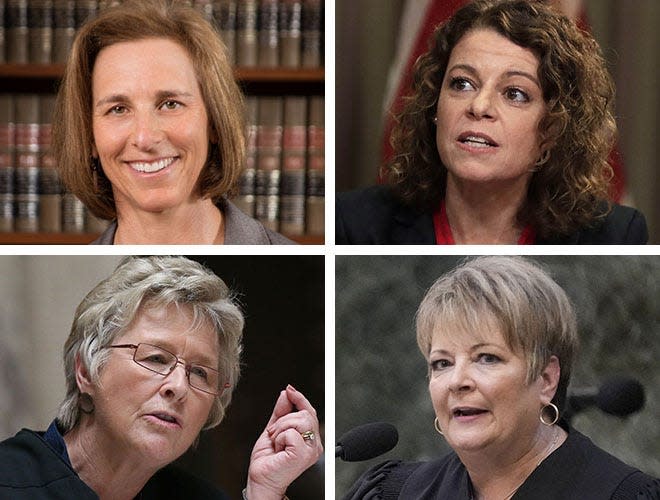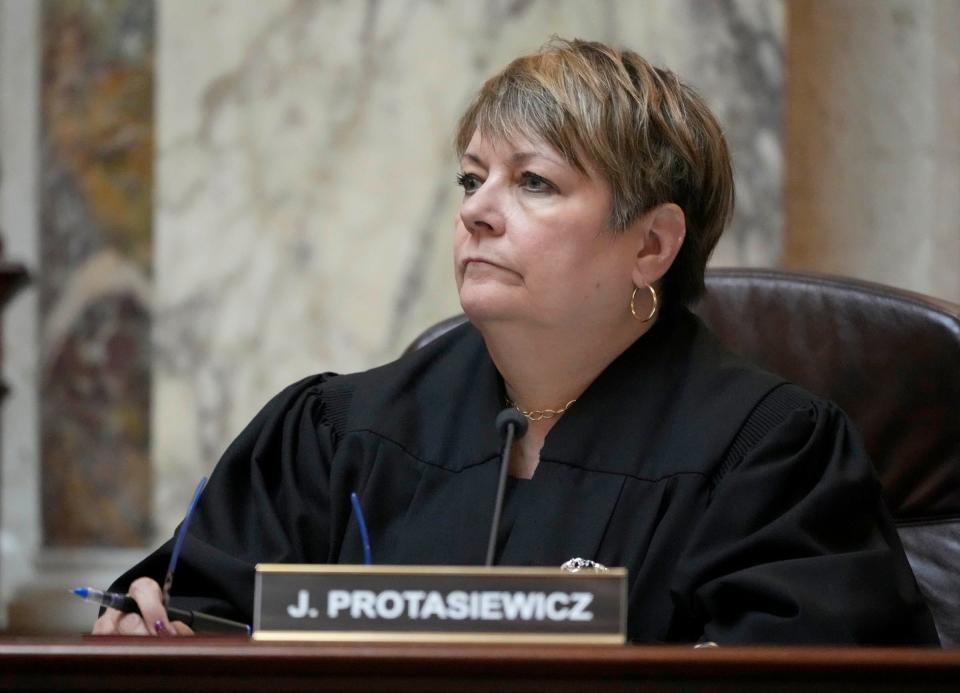Republicans likely to take Wisconsin gerrymandering case back to the U.S. Supreme Court

- Oops!Something went wrong.Please try again later.
MADISON – Republican lawmakers are likely heading back to the U.S. Supreme Court to defend Wisconsin's electoral maps that have delivered huge GOP majorities for years. But they'll first have to convince the nation's high court it has a reason to intervene in the dispute.
The Wisconsin Supreme Court on Friday ordered the Republican-controlled state Legislature to draw new legislative boundaries ahead of the 2024 election, arguing the maps are unconstitutional because many disticts' boundaries are not contiguous — meaning they include pieces of land that are not connected.
The court in a 4-3 decision said it is also prepared to replace the state's heavily gerrymandered maps if the Legislature and Democratic governor cannot agree on a new plan.
Assembly Speaker Robin Vos, R-Rochester, said the U.S. Supreme Court would have the "last word" in the matter, suggesting he plans to ask the nation's high court to reconsider the state Supreme Court's decision.
"We will pursue all federal issues arising out of the redistricting litigation at the U.S. Supreme Court," Vos said in a statement on Tuesday.

In order to get the U.S. Supreme Court to look at the case, the Legislature and its allies will need to make the argument that there was a violation of federal law. That's because, explained Rob Yablon, University of Wisconsin Law School professor and co-director of the State Democracy Research Initiative, the core legal claim in the case — contiguity — is a matter of state law.
The case brought to the court argued the maps violate Wisconsin's Constitution because some legislative districts include pieces of land that are not connected.
"The Wisconsin Supreme Court has the last word on state law questions," Yablon said.
A request for the U.S. Supreme Court to weigh in on a state Supreme Court decision (or a federal appeals court decision) is known as a petition for certiorari, or cert petition. Under U.S. Supreme Court rules, four of nine justices must vote to accept such a case.
"(The majority) did a really intentional job of sticking to very narrow state constitutional issues, which has the effect of insulating a lot of the decision from U.S. Supreme Court review," said Daniel Suhr, a Republican attorney who served in former Gov. Scott Walker's administration. "When a case is decided on only state constitutional grounds, there's not a U.S. constitutional hook for the Supreme Court to rely on in intervening."
That leaves anyone intent on challenging the decision to find a federal hook.
However, Suhr said, it's not clear that, procedurally, the case has reached that point.
"Usually, to go to the U.S. Supreme Court, we have to have a final judgment. The case has to be over and resolved. And it's not clear to me that that is where we are," Suhr said.
More: Here's what to know about the Wisconsin Supreme Court's gerrymandering ruling
One GOP argument could focus on Janet Protasiewicz
One potential approach, legal experts said, would be a federal due process claim based on the court's newest member, Justice Janet Protasiewicz's involvement in the case. Protasiewicz, who was elected with an 11-point margin in April, received about $10 million from the Democratic Party of Wisconsin over the course of her campaign.
Lawmakers and others who called for Protasiewicz to recuse herself from the redistricting case argued new maps could disproportionately benefit Democrats. Protasiewicz, in her decision to stay on the case, argued the party's campaign contributions were not relevant because the party was not a litigant in the case, and because doing so would create an unworkable precedent for all of her colleagues who also have benefited from party contributions.

Under the U.S. Constitution's due process clause, a judge must recuse if they have a financial interest in the case, or if there is a strong possibility of bias. The bar for that has been set very high, Yablon said.
"There are very serious concerns that have been raised in the public debate and presumably raised by the parties," Suhr said. "But at the same time, it's an extremely high standard for anybody to get their case taken by the U.S. Supreme Court, and this one won't be an exception to that general reticence on the part of the justices to intervene especially in state-specific litigation like this."
Both Yablon and Marquette University Law School professor Chad Oldfather said such a claim would be rooted in the 2009 U.S. Supreme Court decision, Caperton v. Massey. In that case, a 5-4 liberal majority ruled that a state Supreme Court justice in West Virginia violated the due process clause by refusing to recuse himself from the appeal of a $50 million jury verdict after the CEO of the lead defendant spent $3 million supporting his campaign.
The court concluded that there is "a serious risk of actual bias" when a person with a personal stake in a case has a "significant and disproportionate influence in placing the judge on the case by raising funds or directing the judge's election campaign when the case was pending or imminent."
The determination includes the relative size of the contribution in comparison to all money supporting the campaign, the total amount spent in the election and how much the contribution appeared to affect the election's outcome.
"This situation is distinguishable from Caperton in lots of ways — the Democratic Party was not a litigant, the issue was a key issue in the campaign (as contrasted with Caperton, where the donations were on behalf of a coal company and were mostly made via an organization called 'And for the Sake of the Kids,') and the defendants are not private parties but rather entities obligated to represent the best interests of the same 'we the people' who elected Justice Protasiewicz," Oldfather said.
"Plus, Caperton was a decision dissented from by most of the court’s conservatives. I’m mildly skeptical that SCOTUS will overturn the decision, but these days who knows," he said.
Yablon agreed that a claim modeled after Caperton would be a "long shot."
U.S. Supreme Court previously focused on the role of race in district lines
A second potential claim, Yablon said, involves considerations of race in drawing district lines under the federal Equal Protection Clause and the federal Voting Rights Act. The U.S. Supreme Court has taken more of an interest in this subject in recent years, he said, including its decision to intervene in a Wisconsin redistricting case two years ago.
The state's current maps are a product of another court battle — Johnson v. Wisconsin Elections Commission — that ultimately landed at the U.S. Supreme Court. In 2022, the nation's highest court threw out election maps drawn by Democratic Gov. Tony Evers. The state Supreme Court embraced a redistricting plan crafted by Republican state lawmakers just three weeks later.
Like now, the decision from the state Supreme Court was released without time to spare, just as candidates could begin circulating petitions to get on the midterm ballot that year.
"When the U.S. Supreme Court intervened in that case, it was because they thought that the governor's map, which the state Supreme Court originally adopted, overly relied on race when drawing districts in the Milwaukee area. This is a really tricky area of law, and it's a little bit of a moving target, because the precedents on this have shifted a bit in recent years," Yablon said, adding that the broad guidelines call for mapmakers to provide fair representation without relying excessively on race.
"That was an issue in the Johnson case, and it could crop up again in this case. That may be something that would give the Legislature and its allies a hook to try to get back up to the U.S. Supreme Court," he said.
Indeed, Vos on Tuesday predicted such a scenario.
"Last time around, the Democrats’ maps racially gerrymandered voters to obtain a political goal. I expect they’ll do so again. The Supreme Court wasn’t fooled by the overt racial gerrymandering before, and it’s my hope that the Court will refuse to allow that or any other violation of federal law this time around, too."
Ruling comes on the cusp of 2024 elections
The state Supreme Court ruling delivers a political landmine ahead of the 2024 presidential cycle that will all but certainly focus on the battleground state of Wisconsin. It's the latest chink in Republican power since GOP dominance in Wisconsin state government began diminishing in 2016, when Donald Trump became president.
Since then, Republicans have lost the governor's office and control of the state Supreme Court.
In a narrowly divided state that often decides statewide races by a few thousand votes, Republicans have held wide majorities in the state Legislature for years.
The current maps tilt heavily in Republicans’ favor, according to a December analysis by the Milwaukee Journal Sentinel.
More: Gilbert: Are Wisconsin's election maps 'rigged'? Here are the reasons the answer is yes
Republicans currently hold 64 of 99 Assembly seats and 22 Senate seats.
The ruling forces half of the state Senate and the full Assembly to run in new legislative districts.
"One of the other principles that the U.S. Supreme Court has laid down is that judges should not override the mechanics of election administration on an emergency basis, close in time to when that election administration is happening, unless the need is dire," Suhr said. "We don't usually see that applied to the non-Election Day parts of the election, but I don't think there's any reason it couldn't be. … So there's certainly also a time limit to this whole thing."
States must draw new election maps once a decade after each census to make sure legislative districts have equal populations. Where the lines go can confer advantages on one political party.
The court ordered lawmakers to have new maps adopted for the August legislative primary. Wisconsin Elections Commission officials have said new maps must be in place by March 15.
Jessie Opoien can be reached at jessie.opoien@jrn.com. Molly Beck can be reached at molly.beck@jrn.com.
THANK YOU: Subscribers' support makes this work possible. Help us share the knowledge by buying a gift subscription.
DOWNLOAD THE APP: Get the latest news, sports and more
This article originally appeared on Milwaukee Journal Sentinel: Wisconsin gerrymandering case could head back to U.S. Supreme Court

